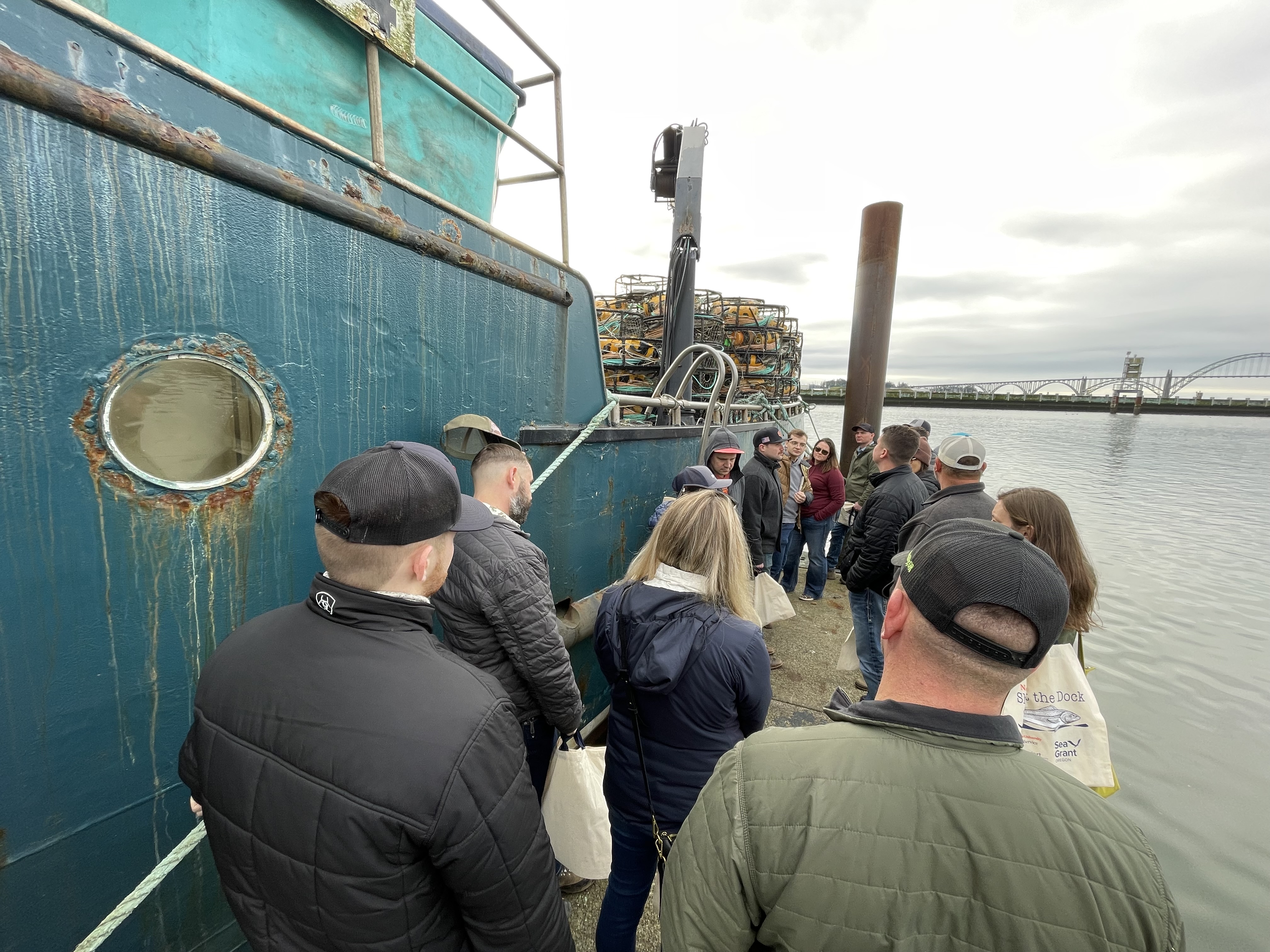Farmers of the Sea
REAL Oregon Covers Commercial Fishing, Seafood in Newport
Editor’s note: This is the third in a series of features by Pac/West Lobby Group Communications Director George Plaven detailing his professional development journey with REAL Oregon. To read previous installments in this series, click the links below:
- Session 1: Klamath Falls
- Session 2: Roseburg
Anyone who knows me knows I love seafood. That’s one of the many reasons I love living in Oregon — getting to enjoy fish, crab, shrimp, and oysters harvested right here along the coast. So, when I saw that REAL Oregon would be visiting Local Ocean for lunch during our January session in Newport, I was ecstatic.
Somehow, it was even better than I expected.
Albacore tuna skewers! Coho salmon sliders! Dungeness crab cakes! I was in heaven. As I loaded my plate, I could see dozens of commercial fishing boats docked in Yaquina Bay through the restaurant’s floor-to-ceiling windows. It reminded me to pause and appreciate the families who made this delicious meal possible. “Farmers of the sea,” we used to call them when I was still reporting at the Capital Press.

Dungeness crab cakes were on the menu at Local Ocean in Newport.
Though lunch was a treat, the real reason we were there was to learn about Oregon’s commercial fishing and seafood industries. According to the State Employment Department, an estimated 1,212 commercial fishers worked in Oregon on an annual average basis in 2023, landing 301 million pounds of seafood worth $178 million.
Setting Sail
Our first tour stop was at the Port of Toledo shipyard, where we stepped inside a large warehouse to find the F/V Collier Brothers undergoing several renovations. The ship’s engineer, Jonas McKinley, said they typically catch 6-8 million pounds of pollack per year along the West Coast, primarily up in Alaska.
The F/V Collier Brothers is a trawler, a type of commercial fishing vessel that drags a large net through the water to catch fish. McKinley said their net is about the size of a football field when fully opened.

Staring up at the F/V Collier Brothers at the Port of Toledo shipyard.
Trawling isn’t the only way to catch fish. Walking along the pier at Dock 5 in Newport, we saw all different kinds of fishing vessels, including seiners, longliners, and salmon trollers. They are uniquely equipped to catch a variety of species, from Pacific whiting (also called hake, used in products like fish sticks and imitation crab) to salmon and tuna.
In 2019, data shows there were 331 commercial fishing vessels that made 4,788 deliveries in the Newport area. The total value of that harvest was $59.3 million. Dungeness crab accounts for the highest overall value of products (42%), while groundfish accounted for the highest overall volume (31%).

A vessel docked in Newport is loaded with Dungeness crab pots.
Catch of the Day
Just a short walk from Dock 5, our class was able to tour seafood processing plants operated by Pacific Seafood. With Dungeness crab season underway, John Moody, facilities manager, gave us a look at their equipment bringing fresh crabs off the boat and preparing them for seafood markets and restaurants.

John Moody, Newport facilities manager for Pacific Seafood, shows how Dungeness crab is processed.
We also had the chance to check out the Yaquina Lab, part of the Central Coast Food Web, providing processing space and facilities for small and independent producers.
Founded by Laura Anderson, who also founded Local Ocean, the Central Coast Food Web (CCFW) aims to knock down barriers for locally caught seafood. According to the CCFW, 90% of seafood sold in Oregon does not actually come from our own shores.
If we could retain just 10% more seafood to sell locally, it would translate into $90 million more per year for coastal communities.
Offshore Wind
Getting into commercial fishing isn’t easy. The equipment and permits are a huge investment, and the work is inherently dangerous. It isn’t an exaggeration to say each boat on the water represents its own small business.
That’s why the subject of offshore wind development is so touchy for the industry.
The federal government identified two areas off the southern Oregon coast for floating offshore wind turbines. Last year, an auction for developers in those two areas was postponed by the Bureau of Ocean Energy Management (BOEM).
We heard from Heather Mann, executive director of the Newport-based Midwater Trawlers Cooperative, and Cari Brandberg, treasurer of the Newport Fishermen’s Wives. They discussed their concerns over how offshore wind could impact fisheries, and joined a chorus of voices from both sides of the issue criticizing BOEM’s process as opaque — “A black box of unknowns,” says Mann.
Last year, the Oregon Legislature passed House Bill 4080, directing the Department of Land Conservation and Development to come up with an “Offshore Wind Energy Roadmap.” Meetings began in November, and a report is due back to lawmakers by June.
How this issue is handled going forward will be critical to the future of Oregon’s coastal communities.

Supplies are lowered into a fishing vessel outside Pacific Seafood in Newport.


